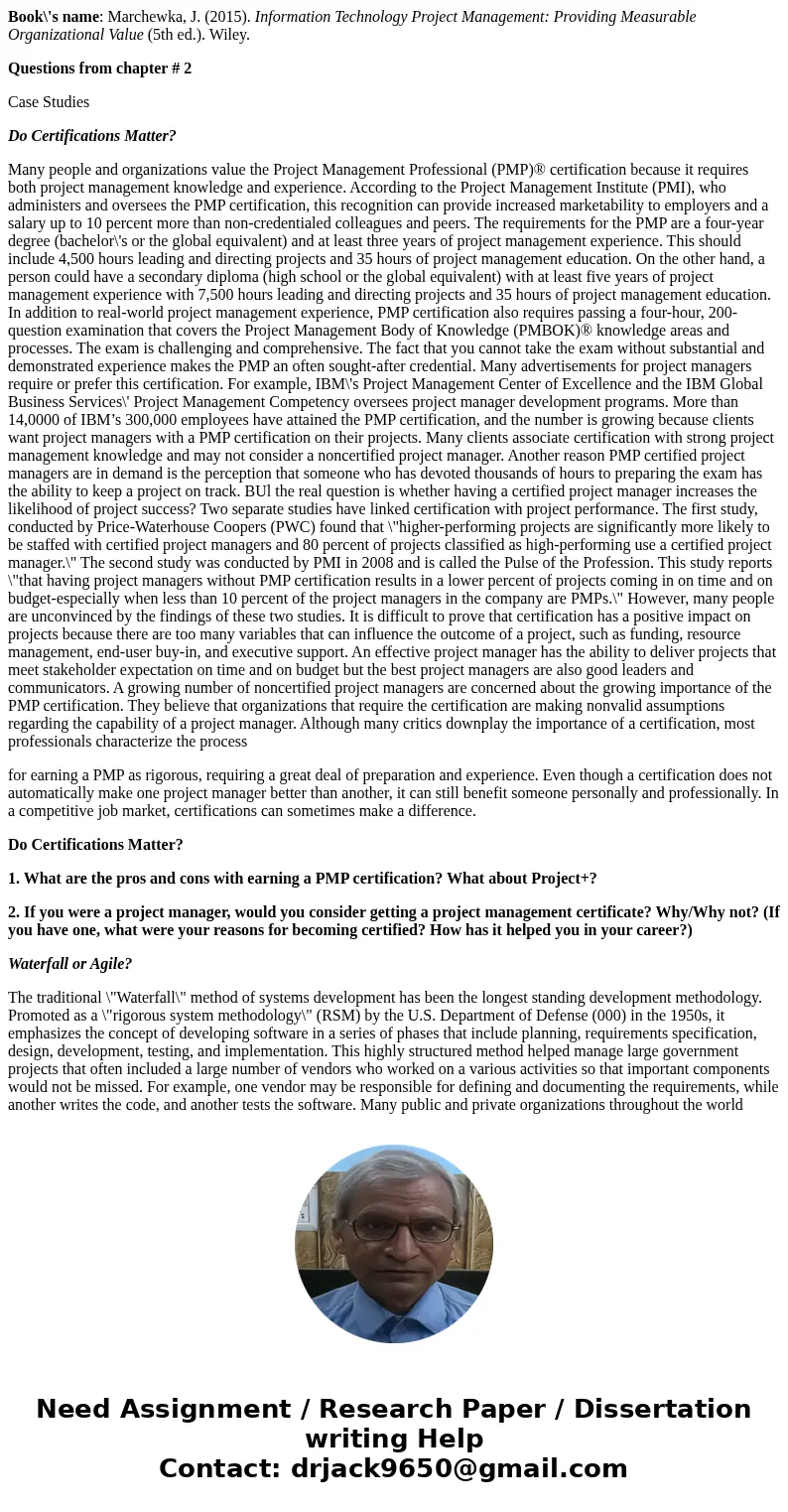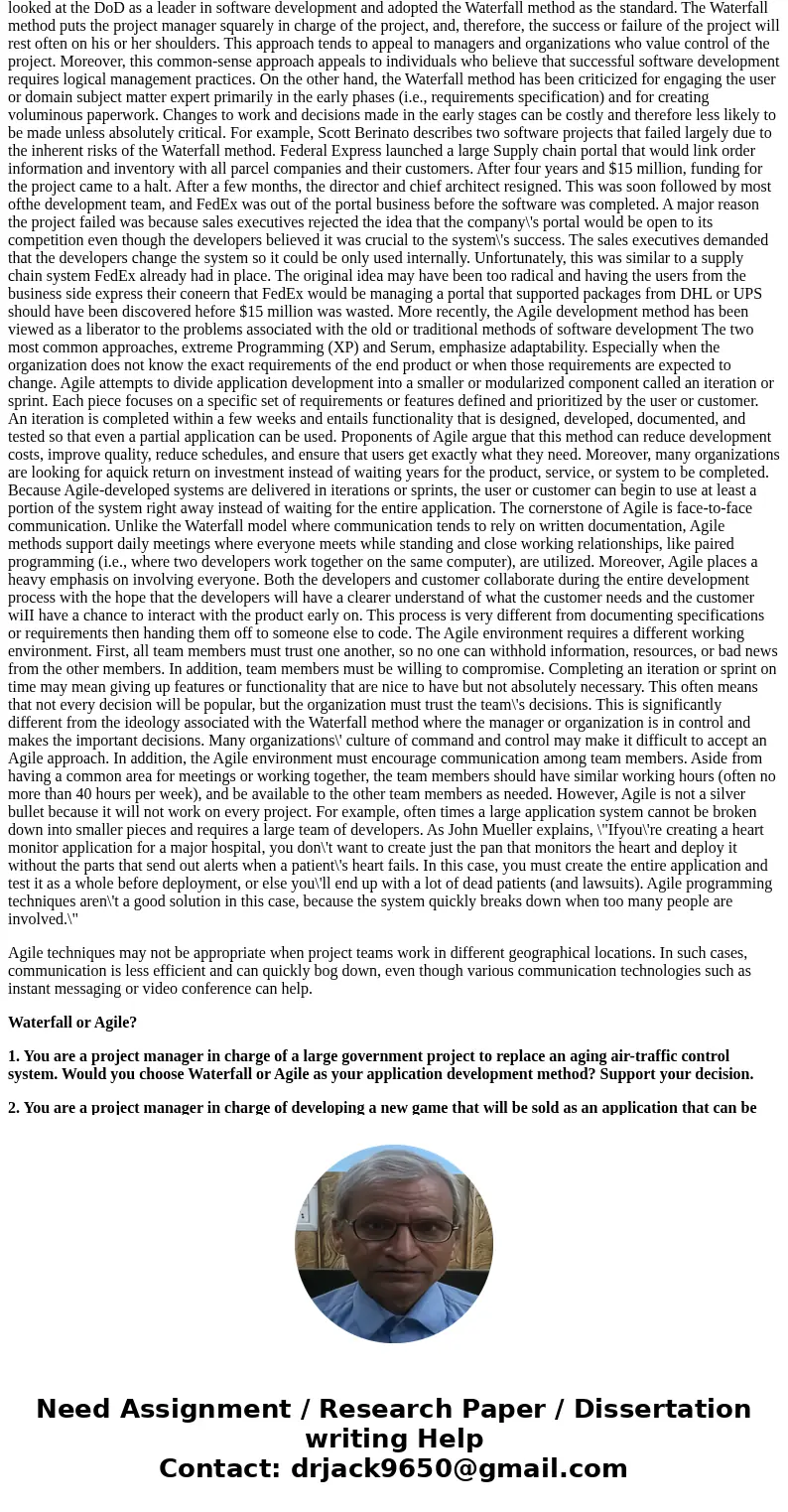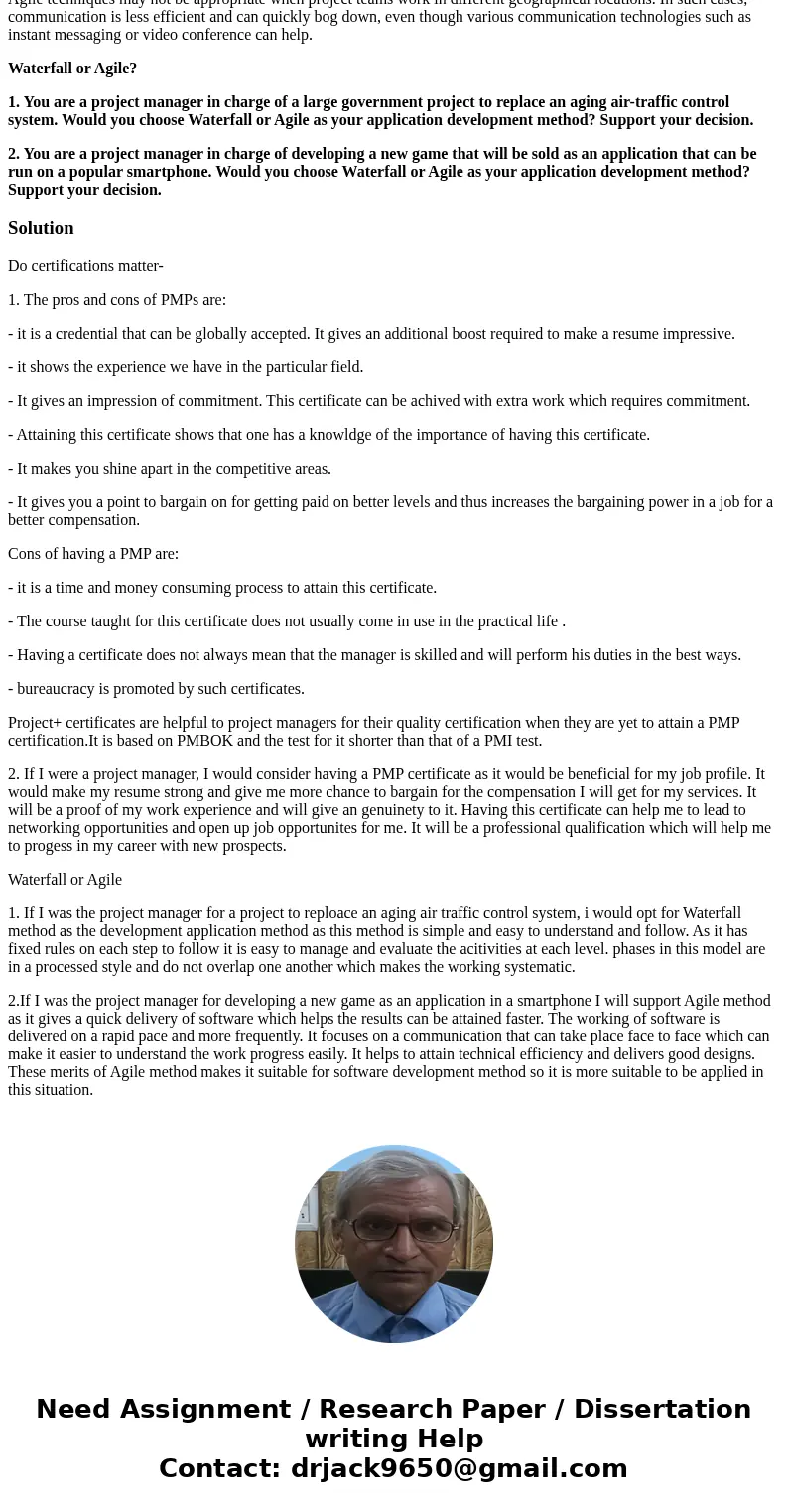Books name Marchewka J 2015 Information Technology Project M
Book\'s name: Marchewka, J. (2015). Information Technology Project Management: Providing Measurable Organizational Value (5th ed.). Wiley.
Questions from chapter # 2
Case Studies
Do Certifications Matter?
Many people and organizations value the Project Management Professional (PMP)® certification because it requires both project management knowledge and experience. According to the Project Management Institute (PMI), who administers and oversees the PMP certification, this recognition can provide increased marketability to employers and a salary up to 10 percent more than non-credentialed colleagues and peers. The requirements for the PMP are a four-year degree (bachelor\'s or the global equivalent) and at least three years of project management experience. This should include 4,500 hours leading and directing projects and 35 hours of project management education. On the other hand, a person could have a secondary diploma (high school or the global equivalent) with at least five years of project management experience with 7,500 hours leading and directing projects and 35 hours of project management education. In addition to real-world project management experience, PMP certification also requires passing a four-hour, 200-question examination that covers the Project Management Body of Knowledge (PMBOK)® knowledge areas and processes. The exam is challenging and comprehensive. The fact that you cannot take the exam without substantial and demonstrated experience makes the PMP an often sought-after credential. Many advertisements for project managers require or prefer this certification. For example, IBM\'s Project Management Center of Excellence and the IBM Global Business Services\' Project Management Competency oversees project manager development programs. More than 14,0000 of IBM’s 300,000 employees have attained the PMP certification, and the number is growing because clients want project managers with a PMP certification on their projects. Many clients associate certification with strong project management knowledge and may not consider a noncertified project manager. Another reason PMP certified project managers are in demand is the perception that someone who has devoted thousands of hours to preparing the exam has the ability to keep a project on track. BUl the real question is whether having a certified project manager increases the likelihood of project success? Two separate studies have linked certification with project performance. The first study, conducted by Price-Waterhouse Coopers (PWC) found that \"higher-performing projects are significantly more likely to be staffed with certified project managers and 80 percent of projects classified as high-performing use a certified project manager.\" The second study was conducted by PMI in 2008 and is called the Pulse of the Profession. This study reports \"that having project managers without PMP certification results in a lower percent of projects coming in on time and on budget-especially when less than 10 percent of the project managers in the company are PMPs.\" However, many people are unconvinced by the findings of these two studies. It is difficult to prove that certification has a positive impact on projects because there are too many variables that can influence the outcome of a project, such as funding, resource management, end-user buy-in, and executive support. An effective project manager has the ability to deliver projects that meet stakeholder expectation on time and on budget but the best project managers are also good leaders and communicators. A growing number of noncertified project managers are concerned about the growing importance of the PMP certification. They believe that organizations that require the certification are making nonvalid assumptions regarding the capability of a project manager. Although many critics downplay the importance of a certification, most professionals characterize the process
for earning a PMP as rigorous, requiring a great deal of preparation and experience. Even though a certification does not automatically make one project manager better than another, it can still benefit someone personally and professionally. In a competitive job market, certifications can sometimes make a difference.
Do Certifications Matter?
1. What are the pros and cons with earning a PMP certification? What about Project+?
2. If you were a project manager, would you consider getting a project management certificate? Why/Why not? (If you have one, what were your reasons for becoming certified? How has it helped you in your career?)
Waterfall or Agile?
The traditional \"Waterfall\" method of systems development has been the longest standing development methodology. Promoted as a \"rigorous system methodology\" (RSM) by the U.S. Department of Defense (000) in the 1950s, it emphasizes the concept of developing software in a series of phases that include planning, requirements specification, design, development, testing, and implementation. This highly structured method helped manage large government projects that often included a large number of vendors who worked on a various activities so that important components would not be missed. For example, one vendor may be responsible for defining and documenting the requirements, while another writes the code, and another tests the software. Many public and private organizations throughout the world looked at the DoD as a leader in software development and adopted the Waterfall method as the standard. The Waterfall method puts the project manager squarely in charge of the project, and, therefore, the success or failure of the project will rest often on his or her shoulders. This approach tends to appeal to managers and organizations who value control of the project. Moreover, this common-sense approach appeals to individuals who believe that successful software development requires logical management practices. On the other hand, the Waterfall method has been criticized for engaging the user or domain subject matter expert primarily in the early phases (i.e., requirements specification) and for creating voluminous paperwork. Changes to work and decisions made in the early stages can be costly and therefore less likely to be made unless absolutely critical. For example, Scott Berinato describes two software projects that failed largely due to the inherent risks of the Waterfall method. Federal Express launched a large Supply chain portal that would link order information and inventory with all parcel companies and their customers. After four years and $15 million, funding for the project came to a halt. After a few months, the director and chief architect resigned. This was soon followed by most ofthe development team, and FedEx was out of the portal business before the software was completed. A major reason the project failed was because sales executives rejected the idea that the company\'s portal would be open to its competition even though the developers believed it was crucial to the system\'s success. The sales executives demanded that the developers change the system so it could be only used internally. Unfortunately, this was similar to a supply chain system FedEx already had in place. The original idea may have been too radical and having the users from the business side express their coneern that FedEx would be managing a portal that supported packages from DHL or UPS should have been discovered hefore $15 million was wasted. More recently, the Agile development method has been viewed as a liberator to the problems associated with the old or traditional methods of software development The two most common approaches, extreme Programming (XP) and Serum, emphasize adaptability. Especially when the organization does not know the exact requirements of the end product or when those requirements are expected to change. Agile attempts to divide application development into a smaller or modularized component called an iteration or sprint. Each piece focuses on a specific set of requirements or features defined and prioritized by the user or customer. An iteration is completed within a few weeks and entails functionality that is designed, developed, documented, and tested so that even a partial application can be used. Proponents of Agile argue that this method can reduce development costs, improve quality, reduce schedules, and ensure that users get exactly what they need. Moreover, many organizations are looking for aquick return on investment instead of waiting years for the product, service, or system to be completed. Because Agile-developed systems are delivered in iterations or sprints, the user or customer can begin to use at least a portion of the system right away instead of waiting for the entire application. The cornerstone of Agile is face-to-face communication. Unlike the Waterfall model where communication tends to rely on written documentation, Agile methods support daily meetings where everyone meets while standing and close working relationships, like paired programming (i.e., where two developers work together on the same computer), are utilized. Moreover, Agile places a heavy emphasis on involving everyone. Both the developers and customer collaborate during the entire development process with the hope that the developers will have a clearer understand of what the customer needs and the customer wiII have a chance to interact with the product early on. This process is very different from documenting specifications or requirements then handing them off to someone else to code. The Agile environment requires a different working environment. First, all team members must trust one another, so no one can withhold information, resources, or bad news from the other members. In addition, team members must be willing to compromise. Completing an iteration or sprint on time may mean giving up features or functionality that are nice to have but not absolutely necessary. This often means that not every decision will be popular, but the organization must trust the team\'s decisions. This is significantly different from the ideology associated with the Waterfall method where the manager or organization is in control and makes the important decisions. Many organizations\' culture of command and control may make it difficult to accept an Agile approach. In addition, the Agile environment must encourage communication among team members. Aside from having a common area for meetings or working together, the team members should have similar working hours (often no more than 40 hours per week), and be available to the other team members as needed. However, Agile is not a silver bullet because it will not work on every project. For example, often times a large application system cannot be broken down into smaller pieces and requires a large team of developers. As John Mueller explains, \"Ifyou\'re creating a heart monitor application for a major hospital, you don\'t want to create just the pan that monitors the heart and deploy it without the parts that send out alerts when a patient\'s heart fails. In this case, you must create the entire application and test it as a whole before deployment, or else you\'ll end up with a lot of dead patients (and lawsuits). Agile programming techniques aren\'t a good solution in this case, because the system quickly breaks down when too many people are involved.\"
Agile techniques may not be appropriate when project teams work in different geographical locations. In such cases, communication is less efficient and can quickly bog down, even though various communication technologies such as instant messaging or video conference can help.
Waterfall or Agile?
1. You are a project manager in charge of a large government project to replace an aging air-traffic control system. Would you choose Waterfall or Agile as your application development method? Support your decision.
2. You are a project manager in charge of developing a new game that will be sold as an application that can be run on a popular smartphone. Would you choose Waterfall or Agile as your application development method? Support your decision.
Solution
Do certifications matter-
1. The pros and cons of PMPs are:
- it is a credential that can be globally accepted. It gives an additional boost required to make a resume impressive.
- it shows the experience we have in the particular field.
- It gives an impression of commitment. This certificate can be achived with extra work which requires commitment.
- Attaining this certificate shows that one has a knowldge of the importance of having this certificate.
- It makes you shine apart in the competitive areas.
- It gives you a point to bargain on for getting paid on better levels and thus increases the bargaining power in a job for a better compensation.
Cons of having a PMP are:
- it is a time and money consuming process to attain this certificate.
- The course taught for this certificate does not usually come in use in the practical life .
- Having a certificate does not always mean that the manager is skilled and will perform his duties in the best ways.
- bureaucracy is promoted by such certificates.
Project+ certificates are helpful to project managers for their quality certification when they are yet to attain a PMP certification.It is based on PMBOK and the test for it shorter than that of a PMI test.
2. If I were a project manager, I would consider having a PMP certificate as it would be beneficial for my job profile. It would make my resume strong and give me more chance to bargain for the compensation I will get for my services. It will be a proof of my work experience and will give an genuinety to it. Having this certificate can help me to lead to networking opportunities and open up job opportunites for me. It will be a professional qualification which will help me to progess in my career with new prospects.
Waterfall or Agile
1. If I was the project manager for a project to reploace an aging air traffic control system, i would opt for Waterfall method as the development application method as this method is simple and easy to understand and follow. As it has fixed rules on each step to follow it is easy to manage and evaluate the acitivities at each level. phases in this model are in a processed style and do not overlap one another which makes the working systematic.
2.If I was the project manager for developing a new game as an application in a smartphone I will support Agile method as it gives a quick delivery of software which helps the results can be attained faster. The working of software is delivered on a rapid pace and more frequently. It focuses on a communication that can take place face to face which can make it easier to understand the work progress easily. It helps to attain technical efficiency and delivers good designs. These merits of Agile method makes it suitable for software development method so it is more suitable to be applied in this situation.



 Homework Sourse
Homework Sourse